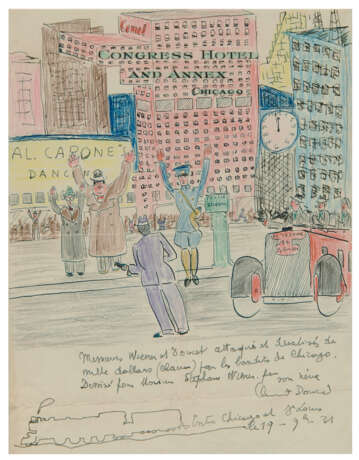Series of seven illustrated letters from Clement Doucet to Jean Wiéner’s children Stephan and Maud during the renowned piano duo’s 1931 American tour
28.09.2023 13:00UTC +00:00
Classic
Prix de départ
2000GBP £ 2 000
| Auctioneer | CHRISTIE'S |
|---|---|
| Lieu de l'événement | Royaume-Uni, London |
| Commission | see on Website% |
Archive
La vente aux enchères est terminée. Vous ne pouvez plus enchérir.

ID 1016384
Lot 140 | Series of seven illustrated letters from Clement Doucet to Jean Wiéner’s children Stephan and Maud during the renowned piano duo’s 1931 American tour
Valeur estimée
£ 2 000 – 3 000
Jean Wiéner and Clement Doucet
WIÉNER, Jean (1896–1982) and Clement DOUCET (1895-1950).
Series of seven illustrated letters from Clement Doucet to Jean Wiéner’s children Stephan and Maud during the renowned piano duo’s 1931 American tour, 9 September to 8 December 1931, the witty vignettes vividly recounting their adventures on the road, the majority featuring comical self-portrait caricatures of the pair, the artist identifiable by his portly figure and bottle-nose, with autograph salutations, captions and annotations in French, each letter signed in black ink ‘Clement Doucet’.
The earliest, dated 9 September 1931, on the headed stationery of the Hotel Saint Hubert, New York, presents a vibrant view of a bustling Broadway, with brightly coloured motorcars and an open-topped double-decker bus dashing past crowded pavements crammed with shoppers, the street illuminated by a theatre billboard for Ziegfeld’s Follies. The next, from Chicago, dated 17 September 1931, on Congress Hotel headed stationery, recalls a spectacular scene from a ‘Bal Nègre’ at the Savoy Ballroom in Harlem, New York, where the red-faced Doucet, labelled ‘C.D.’, cuts a rug amongst the lively Lindy Hoppers on the famous dancefloor, while the genteel ‘J.W.’ makes polite conversation in the foreground. Dated two days later on the same stationery and drawn aboard the train from Chicago to St. Louis, the third depicts the duo being ‘mugged and relieved [attaqués et devalisés] of 1,000 dollars (American) by the bandits of Chicago’, their arms in the air as they are held up by a mobster and his cronies, their motorcar identified as an ‘Al Capone 24 Cylinder’. The fourth, from St. Louis, dated 21 September, on the headed stationery of The Coronado Hotel, presents ‘une petite impression sur l’Amerique’ as a teeming, kaleidoscopic vision of a hectic metropolis, with multi-coloured trains hurtling along elevated interwoven trackways amongst the skyscrapers. In stark contrast, an undated drawing on a sheet of plain wove paper offers an impression of small-town America in portraying their arrival at the tiny Warrensburg Station in Missouri, evidently on the journey either to or from St. Louis, where a handful of locals, all wearing Stetsons, gawk at the Parisian pair. The next, from Akron, Ohio, dated 16 October 1931, on Mayflower Hotel headed stationery, shows the pair at a reception in their honour at the house of Madame Seiberling, wife of Goodyear founder Frank Seiberling, waggishly labelled by Doucet as ‘the Queen of Tyres’, where a long, snaking queue of elegantly dressed guests stand in line to shake the tuxedo-clad musicians by the hand. Titled in English ‘I Like America’ and dated 8 December 1931, the last in the series, on Consolvo Hotels headed stationery, depicts a ‘lecture delivered by Mr. Wiéner in the bathroom of the Coronato Hotel, St. Louis [discours prononcé par Monsieur Wiéner dans le Salle de Bain de l’Hotel Coronato]’, with the winking parenthesis ‘your dad will explain’, the lecture apparently delivered from the bathtub to an amphitheatre of miniature spectators scattered with oversize high denomination dollar bills, the fantastical scene no doubt inspired by the success of the tour.
Starting out as house pianists at the legendary Parisian cabaret bar Le Boeuf sur le toit, the classically trained Wiéner and Doucet formed a duo-piano concert team, billed as ‘jazz a deux pianos’, that toured internationally for over a decade. By blending African-American jazz with elements of classical and European art music, the duo were instrumental in popularising jazz in France. Rather more remarkably, they evidently had considerable success in re-exporting jazz to its homeland. Jackson, Making Jazz French, 119-120.
In French. Seven autograph letters illustrated in ink and coloured pencil on seven pages, the largest 275 x 212 mm, all but one on headed hotel stationery; housed in a modern custom cloth box with chemise.
[With:] a promotional brochure for Wiéner & Doucet’s recordings on Columbia, with cover design by Paul Colin, 1926, and a postcard sized vintage gelatin silver publicity photograph of the duo by Studio Harcourt.
| Adresse de l'enchère |
CHRISTIE'S 8 King Street, St. James's SW1Y 6QT London Royaume-Uni | |
|---|---|---|
| Aperçu |
| |
| Téléphone | +44 (0)20 7839 9060 | |
| Commission | see on Website | |
| Conditions d'utilisation | Conditions d'utilisation |





